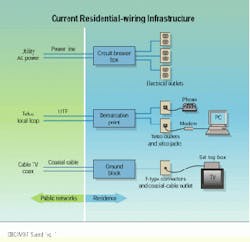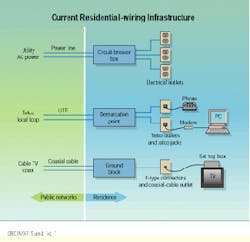The coming revolution in residential wiring
The coming revolution in residential wiring
Frank Murawski
The wiring architecture that is found today in most homes has not changed much over the past quarter century. It consists of three separate and unrelated wiring systems supporting electrical power, telephony, and cable television. This three-part wiring infrastructure is about to change, offering a tremendous opportunity for cabling specialists to expand their markets.
We will call the current residential-wiring architecture a Stage One system, because it represents the baseline infrastructure of a revolutionary growth process that will have at least three overlapping phases, or stages.
The specifics of the three wiring subsystems in a Stage One installation include the following:
- Electrical power from the utility company that is brought into an electrical circuit-breaker box. The rooms of a house are star-wired from this central point. Electrical cable is run from the circuit breakers to individual circuits distributed throughout the home. Standard electrical outlets in each room, which may be daisy-chained to other room outlets, terminate the power cabling.
- Copper wiring, loosely defined as unshielded twisted-pair (utp) cabling, is run from the demarcation point of the telephone company`s public network to locations requiring voice services. The telephone cabling terminates at modular jacks into which can be plugged telephones, modems, personal computers, and other devices. Each telephone twisted-pair cable entering a residence is typically daisy-chained throughout the home. The twisted-pair cable used most often is diw station wire, which is capable of supporting limited bandwidth--up to 4 kilohertz.
- The third residential wiring subsystem brings the cable-TV company`s coaxial-cable drop into the home. The coaxial cable is connected to a ground block supplied by the cable-TV operator and typically attached to the outside of the house. The ground block provides an electrical grounding point for the coaxial cable`s outer shield. The coaxial cable continues from the ground block to a point inside the home where cable-TV services are to be provided, at which location the cable is terminated with an F-type coaxial connector. A coaxial-cable assembly with F-type connectors on each end runs from the coaxial-cable outlet to the set-top box provided by the cable-TV operator. Coaxial cabling in homes is normally structured in a tree and branching architecture; a main trunk runs through the home, with branching coaxial cables dropped to coaxial outlets in different rooms wherever needed for cable-TV reception.
Home-automation control
If the way in which most homes are currently wired can be thought of as a baseline, or Stage One, infrastructure, Stage Two is right around the corner, and includes home-automation control as part of the wiring system`s architecture. This infrastructure is already in place in some residences. Specific examples of home-automation protocols that support this Stage Two wiring architecture are the X10 and cebus standards.
At the heart of such a system can be a central controller, which is a personal computer dedicated to this function or a specialized device that has been programmed offline using a computer. Some home-automation protocols, such as Echelon`s lonworks, do not use a centralized controller at all. Instead, they distribute the intelligence, and hence the control, to the devices attached to the residential network.
All of the existing wiring schemes being used in Stage Two installations can be thought of as local area networks (lans), wiring infrastructures similar to the lans found in today`s commercial applications. In a commercial application such as an office environment, for example, the lan connects personal computers and peripherals into an enterprise network. Similarly, in a residence, the lan connects the home`s electrical appliances, lighting, and heating, ventilating, and air-conditioning devices, as well as electronic devices such as telephones, television sets, and personal computers, into a residential lan.
The central controller receives inputs from programmed subroutines that it stores as instructions: for example, turn the lights on or off at specified times. The controller can also receive inputs from remote sensors. For instance, a photodiode indicating that darkness is approaching will lead the controller to issue a command to turn on the outside lights. Other inputs can come from manual keypads located in different rooms in the home. A keypad can be used to initiate a subroutine, for example, that sets up a room entertainment center; it can dim the lights, close the shades, lower a video screen, and turn on the television. Still another possible input can be wireless devices such as infrared or radio-frequency sources. Existing "zapper" wireless remote units that are currently used to select cable and TV channels are examples of infrared devices.
Broadband services wiring infrastructure
Stage Three wiring will support the coming generation of broadband services that are being promised to the residential market, new applications such as video-on-demand and high-speed Internet access. Two approaches to home-wiring architecture are being considered today for Stage Three:
- The component approach calls for the manufacturer to provide all of the passive connecting products, which include a centralized distribution panel and various outlets. The cable itself will be available from many different cable manufacturers.
- The second approach calls for a structured wiring system analogous to the infrastructures currently being installed in commercial and institutional building environments. A prime example of this type of commercial system is the Systimax structured wiring system offered by Lucent Technologies. In this case, a single manufacturer supplies all of the wiring-system infrastructure, including the connecting products and the cabling.
Both of these wiring approaches depend on an architecture that supports three different cabling media, including utp cable, coaxial cable, and powerline carrier cabling. The residential gateway is the key connection product linking all external services to the different home networks. Three major home networks, based on type of cable used, are distributed throughout the home, with outlets installed where appropriate to connect the various appliances and devices. The residential gateway can be as simple as a patch panel, or it can be a more sophisticated arrangement, such as a service center incorporating video splitting and amplification electronics that facilitate the distribution of video throughout the home.
The residential gateway will be an intelligent microprocessor-based device like a personal computer. It will consist of three major subsystems:
- a fixed microprocessor motherboard and associated memory
- network services plug-in boards
- home network plug-in boards
Inside the residential gateway, a high-speed data bus will provide the interconnections between the three major subsystems. The microprocessor and memory boards will be permanently installed in the gateway enclosure in a fixed location. The residential gateway will be software-controlled by the microprocessor. For example, under software control the microprocessor will enable any incoming network line to be connected to any outgoing home networking line.
The exact configuration and splitting up of responsibilities for the gateway device are not clear at this time. However, it does appear that the protocol involved will have network service providers plugging in their network boards as part of the installation procedure, bundling the cost of the board into the initial installation cost. For example, a telephone company providing Integrated Services Digital Network (isdn) service to the home will plug in an isdn interface board, while a cable-TV operator supplying high-speed Internet access will install the appropriate cable-modem board.
It is anticipated that multiple service providers will need to have access to the residential gateway, which may lead to the entire gateway, or perhaps just the network section of the gateway, being mounted on the exterior of the residence. The home controller plug-in boards would then be the responsibility of the homeowner, while the network boards would be maintained by service providers.
The homeowner will probably be responsible for initially purchasing the gateway enclosure, with its microprocessor and memory boards bundled in with the high-speed bus, from a computer retail store such as Radio Shack. The high-speed bus will be pre-wired to printed circuit connectors inside the enclosure, permitting different network or home controller boards to be plugged in. As new network services are connected by service providers, the homeowner will be required to purchase the appropriate home-network controller boards so that these services can be connected to the desired locations within the home. The gateway will provide for the transparent connection between the outside service network and the inside home network.
The residential gateway, then, has as its primary functions to provide key gateway, bridging, and switching functions, including
- the physical interface upon which to terminate all external networks coming into the home, and
- the enabling platform permitting residential services to be delivered to consumer devices such as telephones, TVs, and PCs. This means that different manufacturers of TVs, VCRs, telephones, and other consumer electronic and telecommunications equipment will be able to connect directly to the residential wiring via the residential gateway, without the need for special hardware or software interfaces. This provides the same capabilities offered currently when you plug any manufacturer`s telephone into any modular jack in the home.
The residential gateway will support both copper utp and coaxial cabling inside the home. It is becoming apparent that Category 5 utp cabling will be needed for the new services being forecast, while Category 3 utp cable will be relegated to applications with low bandwidth requirements, such as home-automation control, security, and similar functions. On the external or public- network side of the residential gateway, the device will need to support standard twisted-pair telephone wiring, coaxial cable, and broadband optical fiber such as that used in hybrid fiber/coaxial-cable networks, as well as wireless communications.
Home wiring currently being installed should provide flexibility and the capability to support these new high-bandwidth applications. To accomplish this, residential wiring, including Category 5 utp and coaxial cable, should be installed throughout the home as required. This wiring can be connected back to a centralized distribution panel that can be replaced by a residential gateway in the future.
Today`s residential-wiring infrastructure, found in most North American homes, includes three separate subsystems: AC power lines from the local power company, local-loop telephone service from the local phone company, and a coaxial cable from the cable-TV company.
The residential gateway will consist of an enclosure containing a microprocessor-based controller and memory boards. A high-speed bus will connect these units to application-specific printed circuit boards installed by both the service provider and the homeowner.
Frank Murawski is president of ftm Consulting (Hummelstown, PA), a firm specializing in market research and development of premises cabling systems. A recent collaboration with World Information Technologies (wit) has resulted in joint development of a new market- research report on the residential wiring market. For more information, contact Frank Murawski at (717) 533-4990, or call wit at (516) 754-5700.


